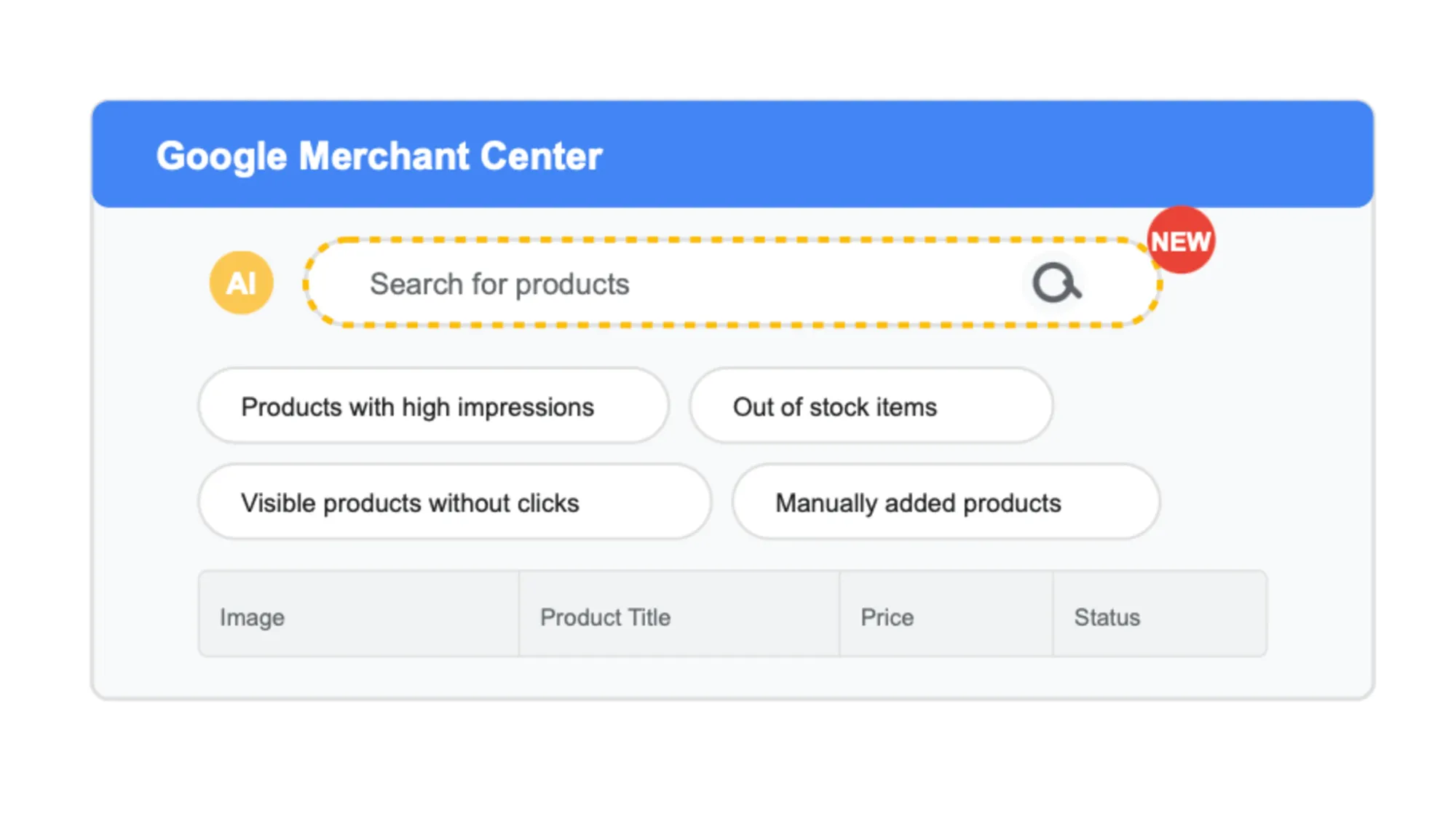Google launches AI-powered search filters for Merchant Center
Marketers can now use plain English queries to filter product data.

Google has introduced a new AI-powered search functionality within Google Merchant Center that enables marketers to filter product data using natural language queries, significantly improving how e-commerce managers analyze their product catalogs.
Get the PPC Land newsletter ✉️ for more like this
The new "Search for Products" feature was launched on April 28, 2025, just four days ago. This addition to Google Merchant Center allows users to search using more defined options. When accessing their Google Merchant Center account and clicking on products, users will notice a new icon labeled "Search for Products".
Google added this new way to search for products in the Google Merchant Center console. Users can click on a new search button named "Search for Products" that lets them pick from a pre-defined set of searches or type their own search queries.
The functionality brings natural language processing to product data management, allowing marketers to filter their catalog using plain English phrases rather than navigating complex filter options.
How the feature works
When users click on the "Search for Products" icon, they are presented with pre-built query options. It displays options in plain English, such as "manually added products," "products that cost me clicks but are out of stock," and "manually edited products that aren't showing up."
Google Merchant Center will dynamically add the query as a filter for the products within the platform. This allows for rapid identification of opportunities and issues within product catalogs.
Users can select from these pre-defined options or create custom queries. For example, a marketer might use a query like "visible products without clicks" to quickly identify products that are displaying in search results but not receiving user engagement. This specific filter reveals products that may need optimization of titles, images, or pricing to improve performance.
Another example provided in the demonstration is the query "high impressions but low clicks," which filters for products receiving fewer than 10 clicks despite having significant visibility.
Technical implementation
The feature leverages artificial intelligence to interpret natural language queries and translate them into applicable filters for product data.
Here's how the feature works step by step:
- Click the "Search for Products" button
- View pre-defined searches or enter a custom query
- Select a pre-defined search or enter a custom one to activate the filter
- Review the filtered results
Enhanced data export functionality
In addition to improved search capabilities, Google has also fixed an issue with filtered downloads. Previously, clicking the download icon would export all products regardless of active filters. The update ensures that only filtered data is exported, allowing for more targeted analysis.
This enhancement streamlines the workflow for marketers who need to analyze specific segments of their product catalog or share filtered data with team members.
Limited availability
The new search functionality is currently in a phased rollout. The feature is not available on all accounts. Testing revealed it's accessible on Australian accounts but not yet on US accounts, indicating a regional rollout strategy.
Google is gradually rolling out the feature, and it may not yet be available in all merchant accounts worldwide. No official timeline has been provided for complete global availability.
Potential integration with performance data
E-commerce specialists are already exploring how this feature might integrate with other data sources. There's particular interest in how the new search functionality might work with performance data from campaigns. Specifically, merchants are looking at how supplemental feeds containing conversion data, conversion values, and other performance metrics from Performance Max campaigns might enhance the search capability.
This potential integration could allow for even more sophisticated filtering, such as identifying products with high impressions but low conversion rates or highlighting high-margin products with poor visibility.
Click potential clarification
The demonstration also addressed a common misconception about the "click potential" metric displayed in Google Merchant Center. Many merchants mistakenly believe this metric is solely based on the product information they submit. However, it's actually calculated using historical performance data as well.
This clarification helps merchants better understand how Google evaluates products for potential performance in shopping campaigns and organic product listings.
Significance for the marketing community
The introduction of natural language search in Google Merchant Center represents a significant shift in product data management for several reasons:
- Reduced technical barriers: Marketing teams can now analyze product performance without mastering complex filtering syntax or remembering specific attribute names.
- Improved efficiency: Quick identification of underperforming products allows for faster optimization cycles.
- Better data segmentation: The ability to create complex filters through simple language makes sophisticated analysis accessible to more team members.
- Enhanced reporting: The fixed download functionality ensures that filtered data can be easily extracted for reports and further analysis.
- Potential for AI expansion: This feature hints at Google's broader AI integration strategy for Merchant Center, potentially leading to more intelligent product optimization recommendations in the future.
The feature has generated positive reception within the e-commerce marketing community. Industry professionals have described it as "excellent work" and thanked the demonstrator for sharing insights about the new functionality.
Timeline of events
- April 28, 2025: Google launches the new "Search for Products" feature in Google Merchant Center
- April 28, 2025: Feature confirmed available on Australian merchant accounts
- April 28, 2025: Feature confirmed unavailable on US merchant accounts
- April 28, 2025: First demonstration video published showing the feature in action
- May 2, 2025: Industry publications begin reporting on the new feature

